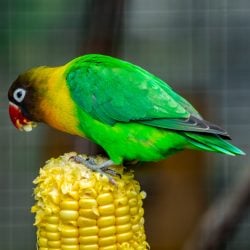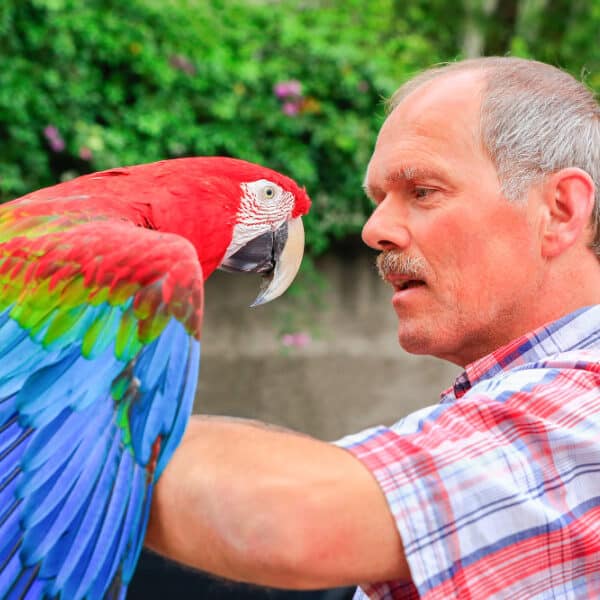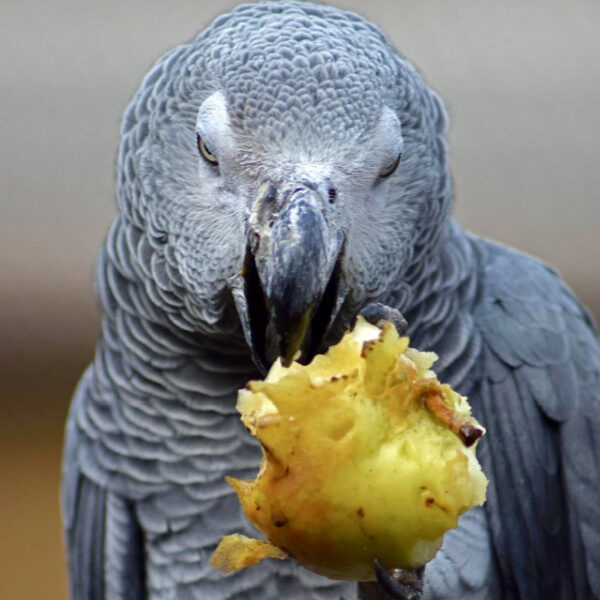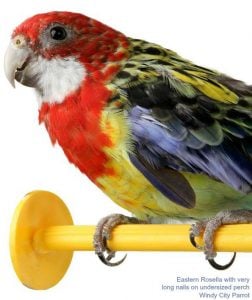Last Updated on by Mitch Rezman
I hope the post on the Ultimate Bird DIY First Aid Kit will become part of your avian reference library.
We’re going to break down the first aid thing into several manageable parts.
Before we do here’s a pop quiz: What was the cashier at Walgreens thinking when I bought Pedialyte, saline, eyewash, plastic gloves & a tube of KY Jelly? (for the birdy first aid kit?)
We designed the ultimate bird first aid kit for a broad range of species, so you don’t need everything in it.
As an example, you really need needle-nose pliers to pull blood feathers from a blue and gold macaw, but only strong tweezers for a smaller bird like a parakeet.
Everyone likes to think of themselves as being prepared for disaster and life’s certain cuts and scrapes.
I’ve personally sutured a dog in a garage (after 5 minutes of training by my vet 🙂
I’ve yanked shards of glass out of more than one dog’s paw and gotten many dogs and children bandaged over the years.
Sutures are easy to come by if your vet is a fellow musher but for the most part most dog, and I presume cat medical emergencies, can be treated with a human first aid kit.
Removing a little fur left on the paw in the haste to get a wound bandaged, is something a dog will get over pretty quickly. Cutting off feathers is only a last resort.
It’s also important to note that a bird first aid kit is really there to help either stabilize a bird in an emergency or be able to begin the healing process for a minor injury.
As a rule of thumb, if you think for a second, that your bird needs veterinary care – it does!
By now you’re asking yourself the nagging question.
“Do I really need all this stuff, what could possibly happen my bird?” Well, we thought of that too.
Here’s our list of 41 ways we kill or injure our pets birds – additions welcome.
Let’s start with the basics.
Do you have all the necessary phone numbers in an easily accessible area like on your refrigerator door?
You’ll want emergency veterinary numbers and perhaps even directions to the vet clinic, how about the ASPCA Animal Poison Control Center at 888-426-4435 (A $65 consultation fee may apply).
Yep, we’ll be talking about poisons and poison control in the future.
Next, the first of many reasons is that birds are different than cats and dogs when experiencing even the smallest of medical trauma.
Always follow this plan if your bird or parrot is injured.
Prevent
Prevent further injury.
If your bird is caught on a toy, cut the toy out of the bird cage and then get the bird released from the toy or accessory.
Restraint
Get the bird restrained, larger birds should be toweled.
Stabilize
Calm the bird.
Talk to it, and gently stroke it while assessing the injury.
Treat
Treat what you can using the methods described below.
Warmth
Ensure your bird has additional heat (heating pad, hot water bottler, cage panel heater) so it doesn’t waste calories warming itself.
Transport
If you think the bird needs a vet, this would be the time to go.
As an example, let’s say a bird gets its leg band caught in a bird cage accessory breaking its tibiotarsal (shin bone).
In this scenario, a bird has a higher chance of dying from stress than from the injury itself.
This is why you will want to stabilize the bird before tending to the injury.
Orthopedic injuries usually aren’t life-threatening so work on the stabilization of the bird first something called “re-establishing homeostasis” in veterinary terms.
Feathered facts about bird bones
We know that bird bones are hollow, enabling them to fly but what you might not know is these hollow bones are considered “pneumatic” bones that contain air-filled canals aiding in the respiratory cycle during flight.
Feathered facts about bird skin
A bird’s skin is much more delicate and thinner than mammal skin and far less elastic.
The skin is secured firmly to the bird’s bones, especially in two highly mechanical areas, wings & feet.
The top layer of skin, the dermis holds smooth muscles and feather follicles which is how a bird determines the position of its feathers.
The tissue beneath the skin, (the subcutis) is made up of fat, striated muscles, and connective tissue.
A broken bone is usually visible, a fracture sometimes can only be determined with an x-ray.
If your bird experiences a broken bone and your bird first aid kit is still on your shopping list you can resort to the Mitch-guyver method of treating avian orthopedic injuries.
A feather quill, cut from a flight feather can serve as a splint and can be wrapped with masking tape.
Feathered Factoid about birds wings
Falconers imp wings to keep the birds feathers in perfect shape.
Imping has been around for several thousand years.
Originally done with steel pins and vinegar (causing the steel pins to corrode binding the two halves of the feather) but now done with bamboo or the shafts of smaller feathers and what else – super glue.
You can see why we’re going to break this first aid thing into a bunch of different parts, but we’re hoping you feel the conversation will be worth it.
https://www.youtube.com/watch?v=_DIw_quRXoU
Of course we didn’t forget the of list of 60 nasty things birds shouldn’t be around – here you go:
- Aerosols
- Ammonia
- Automobile exhaust/carbon monoxide
- Bleach
- Burning foods
- Cold drafts
- Cooking oils
- Curtain weights
- Deodorizers
- Disinfectants
- Dryer Sheets
- Extreme temperature changes
- Fabric softeners
- Fishing sinkers
- Fumigants
- Furniture polish
- Gasoline fumes
- Germicides
- Glues
- Hot stoves and heaters
- Household keys (some)
- Improperly glazed bowls
- Insecticide sprays and foggers
- Lead hardware
- Lead paint chips
- Lead shot
- Lead weights
- Lead-coated household products
- Lead-containing Venetian blinds
- Linoleum Tile
- Liquid potpourri
- Mirrors
- Mothballs
- Nail polish
- Non stick cookware
- Open doors
- Open flames
- Paint
- Perfume/Cologne
- Plumbing material
- Saliva from any animal, including humans
- Sanitizers
- Scented Candles
- Scented Laundry Detergent
- Self-cleaning ovens
- Smoke (any source)
- Solder in stained glass
- Some antiques
- Some artist paints
- Teflon anything
- Tire weights
- U.S. pennies minted after 1983
- Water deeper than 1 inch
- Windows
- Wine/champagne bottle foils
- Zinc hardware (washers, nuts, wire)
- Zinc on bird toys
- Zinc on chain
- Zinc on galvanized wire cages
- Zinc on older water or food bowls
We know why you read our blog.
We never list possible problems without providing solutions.
Deep breath
Let’s circle back to first aid.
Assuming you’ve taken the time to build your own bird first aid kit, it’s important to remember the basics.
Once you’ve assembled all the tools for your first aid kit you should wash them with antibacterial soap or clean them with steam cleaner and then wrap them in washcloths prior to storage.
This will help reduce the chance of bacteria causing zoonotic disease (diseases passed from humans to animals and vice versa).
https://www.youtube.com/watch?v=POkLueHfTgY
I’m sure many of you seen the “mayhem” commercial by Allstate which does a nice job of what bringing what could happen into plain mental sight.
Let’s discuss some mayhem the bird “may” encounter.
Please keep in mind, were giving you the tools to perform bird first aid not avian surgery.
If your bird suffers a broken bone or severe burn, an emergency vet visit is in order.
If you can fix things – fix things, like broken blood feathers.
But if the bird is to end up at the vet use this information to stabilize the animal, make sure the injury is stabilized and the bird is toweled, warmed, crated and go!
Blood Feathers
The most common bird first aid issue you will encounter.
A bird can bleed to death from a single blood feather.
One thing you’ll want to know how to deal with in your bird’s lifetime is a blood feather.
There’s too many feathers and they come back on a regular basis, not to break occasionally – I guarantee it will happen to your bird in it’s lifetime. It’s a simple fix, learn how to do it here.
Bleeding of any kind
We’d much rather see you grind a birds toenails with an electric nail trimmer rather than clipping them.
Just 15 or 20 drops of blood, about a teaspoon represents approximately 10% of an average size cockatiel’s total blood in their system.
Some qwik stop clotting products are very effective while providing soothing antiseptic relief.
If you don’t have any on hand go to the pantry and get some cornstarch or go into the bathroom, grab a bar of soap and drag the bleeding nail across the bar soap.
Cross species bites
These can be devastating for bird.
I talk about a cockatiel that I had many years ago getting attacked by one of my dogs and surviving – here.
Dog and cat bites can cause infection from even small puncture rooms or worse major internal injuries and multiple bone fractures.
IF you feel the bird can be saved, do the drill – stabilize the bird, make sure the injury is stabilized and and the bird toweled, warmed, crated and go to the vet!
Fractured or broken bones in birds
We talked about broken bones and stabilizing the bird prior to seeking veterinary help, a couple weeks ago I want to touch on some other points.
There are so many ways a bird in or out of the cage can break a bone I’m amazed it doesn’t happen more often.
- Wing feathers get caught in cage bars.
- Toes get caught in the crack of an un-inspected wood toy.
- You forget to notice the bird on the top of the bathroom cabinet door when you close it.
Sometimes you’re part of the trauma but sometimes you have to be a detective.
If you see a bird’s wing drooping or your bird can’t move it’s wing you’re probably dealing with a broken bone.
If a leg looks like is in a position that’s not normal or the leg is swollen or bruised, you’re probably dealing with a broken bone.
Know what you’re dealing with so you know how to deal with it. Learn how to deal with it here.
Overheated birds
Once again the possibilities are endless, from failed air-conditioners to birds left in hot cars while you’re running errands to and from the vet.
What your bird’s temperature comfort range?
If you’re comfortable your birds comfortable – If you’re hot you bird’s hot.
Pedialyte, a pediatric oral electrolyte solution administered in eyedropper is ideal.
Gatorade works too
A teaspoon of salt in a pint of water will work in a pinch. Mist entire bird with water.
Reduce the heat if at all possible with an air conditioner.
https://www.youtube.com/watch?v=vPr20-F8d0w
Bird burns
Steam, dinner cooking on the stove – hot soup or frying chicken.
Water type burns should be misted with cool water or the bird should be simply placed under a faucet.
For foot and leg burns, dip the extremity into a cup of ice water.
Use a topical antibiotic cream, nothing with grease especially things like butter.
Anything greasy will retain the heat.
Conversely, if you’re dealing with the grease burn first use cornstarch to wick the oil and then run the bird under cold water.
Chemical or acid burns – think toilet bowl cleaner – flush the bird with cold water and then apply a mixture of baking soda and water as a light paste.
Alkali burns on birds from household cleaners that contain things like ammonia should be treated with running water and then vinegar to neutralize the chemical.
If your bird burnt its beak while chewing on the electrical cord that it’s been nibbling on for the past two months, you’re on your own.
We haven’t figured out how to treat beak burns.
My all-time favorite scenario is that you been smart enough to make sure the bird is not the kitchen while you cook.
Dinner’s over and your birds back in the kitchen with you helping you wash dishes expecting perhaps a sink bath.
While you’re thinking about how much fun the bath is going to be in just a few minutes, your bird decides that it wants to bathe now.
In less than 1.5 seconds, it hops off your back, lands on the cool edge of the pot on the stove and then plunges its chest into the very cool pot of oil that you used to fry tonight’s chicken.
Let’s let that scenario sink in for a moment.
You will not panic because you read these newsletters weekly.
You will calmly grab and towel your bird.
Start by getting the oil out of the nares (nasal passages), mouth and eyes using a moist Q-tip.
Then clear a compartment in the sink, fill it with warm water and a few drops of dish soap.
Dawn dish soap is preferred by wildlife rehabbers.
Just keep washing the feathers and moving soapy water in the direction of the feathers.
Keep dipping the bird in and out of the water and then rinse and repeat.
Not a bad idea to use a blow dryer and even if it’s in the summer get that winter cage heater warmed up so the area around the cage is in the upper 80s until your feathered fluff ball is a fluff ball again.
Squawk at you next week
Written by Mitch Rezman
Approved by Catherine Tobsing
your zygodactyl footote
Author Profile
Latest entries
 Bird BehaviorJune 26, 2025How is it Parrots Are Problem Solvers Social Animals and Even Use Tools?
Bird BehaviorJune 26, 2025How is it Parrots Are Problem Solvers Social Animals and Even Use Tools? Bird & Parrot AnatomyJune 25, 2025How a Tiny Chemical Modification Makes Parrots Nature’s Living Paintings
Bird & Parrot AnatomyJune 25, 2025How a Tiny Chemical Modification Makes Parrots Nature’s Living Paintings PigeonsJune 20, 2025How Do Parrots Thrive in Cities Outside Their Native Habitats?
PigeonsJune 20, 2025How Do Parrots Thrive in Cities Outside Their Native Habitats? Feeding Exotic BirdsJune 20, 2025Is Corn On the Cob Safe for Pet Birds?
Feeding Exotic BirdsJune 20, 2025Is Corn On the Cob Safe for Pet Birds?





Sue Baker
20 May 2018I live in the las vegas area, can a scorpion hurt my African grey or will he eat it?
WindyCityParrot
20 May 2018I would error on the side of caution and protect your bird from all predators Sue
Sue Baker
20 May 2018Thank you for the speedy response. I caught a small scorpion today in my home without incident. My Grey is only 3 years old and the cutest/sweetest boy I’ve ever met. He is indoor flighted and comes and goes back to his cage when told. Thanks for all of the info and list of 60 reminders.
Sue
Lisa
22 May 2018Thanks for this list, Mitch!
WindyCityParrot
22 May 2018Glad to help Lisa
WindyCityParrot
26 Jul 2018agreed – you can find more here Diana -> https://windycityparrot.com/blog/2014/04/06/kill-injure-pet-birds/